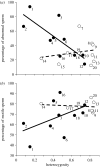Reduced heterozygosity impairs sperm quality in endangered mammals
- PMID: 19324650
- PMCID: PMC2679910
- DOI: 10.1098/rsbl.2008.0734
Reduced heterozygosity impairs sperm quality in endangered mammals
Abstract
Inbreeding causes increases in homozygosity and is commonly associated with reductions in fertility and embryogenesis. Although the mechanisms underlying such effects are unknown, recent work has suggested that inbred males may suffer impaired ejaculate quality, thus providing a functional explanation for reductions in reproductive function in inbred populations. However, the relationship between inbreeding and sperm quality remains controversial, particularly in wild populations where the level of inbreeding is typically estimated using neutral molecular markers. Such markers are thought to reflect genome-wide levels of heterozygosity only under restricted conditions, and rarely in outbred populations. Here we employ a comparative approach that takes account of these criticisms and evaluates the evidence linking inbreeding to reductions in sperm quality in 20 mammal species. We focus on sperm abnormalities and sperm motility, which are key determinants of male fertility in many species. We show that species with reduced mean heterozygosity have impaired ejaculated quality, although subsequent analyses revealed that these effects were confined to endangered populations. Our findings therefore support the notion that inbreeding can severely impair sperm quality while concomitantly addressing criticisms surrounding the use of heterozygosity estimates to estimate the level of inbreeding.
Figures

Similar articles
-
Heterozygosity-fitness correlations and inbreeding depression in two critically endangered mammals.Conserv Biol. 2012 Dec;26(6):1121-9. doi: 10.1111/j.1523-1739.2012.01916.x. Epub 2012 Aug 16. Conserv Biol. 2012. PMID: 22897325
-
Inbreeding depression in sperm quality in a critically endangered amphibian.Zoo Biol. 2020 May;39(3):197-204. doi: 10.1002/zoo.21538. Epub 2020 Mar 6. Zoo Biol. 2020. PMID: 32141645
-
Reduced heterozygosity depresses sperm quality in wild rabbits, Oryctolagus cuniculus.Curr Biol. 2006 Mar 21;16(6):612-7. doi: 10.1016/j.cub.2006.02.059. Curr Biol. 2006. PMID: 16546087
-
Inbreeding and reproduction in endangered ungulates: preservation of genetic variation through the Organization of Genetic Resource Banks.Reprod Domest Anim. 2006 Oct;41 Suppl 2:82-92. doi: 10.1111/j.1439-0531.2006.00772.x. Reprod Domest Anim. 2006. PMID: 16984472 Review.
-
Role of NGF on sperm traits: A review.Theriogenology. 2020 Jul 1;150:210-214. doi: 10.1016/j.theriogenology.2020.01.039. Epub 2020 Jan 22. Theriogenology. 2020. PMID: 32000995 Review.
Cited by
-
Sex-specific effects of inbreeding on reproductive senescence.Proc Biol Sci. 2018 May 30;285(1879):20180231. doi: 10.1098/rspb.2018.0231. Proc Biol Sci. 2018. PMID: 29794043 Free PMC article.
-
Ethical Concerns about Fashionable Dog Breeding.Animals (Basel). 2024 Feb 28;14(5):756. doi: 10.3390/ani14050756. Animals (Basel). 2024. PMID: 38473141 Free PMC article. Review.
-
Inbreeding reveals mode of past selection on male reproductive characters in Drosophila melanogaster.Ecol Evol. 2013 Jul;3(7):2089-102. doi: 10.1002/ece3.625. Epub 2013 Jun 3. Ecol Evol. 2013. PMID: 23919154 Free PMC article.
-
The condition-dependence of male genital size and shape.Ecol Evol. 2024 Mar 17;14(3):e11180. doi: 10.1002/ece3.11180. eCollection 2024 Mar. Ecol Evol. 2024. PMID: 38495435 Free PMC article.
-
Males and females contribute unequally to offspring genetic diversity in the polygynandrous mating system of wild boar.PLoS One. 2014 Dec 26;9(12):e115394. doi: 10.1371/journal.pone.0115394. eCollection 2014. PLoS One. 2014. PMID: 25541986 Free PMC article.
References
-
- Aparicio J.M., Ortego J., Cordero P.J. Can a simple algebraic analysis predict markers–genome heterozygosity correlations? J. Hered. 2007;98:93–96. doi:10.1093/jhered/esl055 - DOI - PubMed
-
- Asa C., Miller P., Agnew M., Rebolledo J.A.R., Lindsey S.L., Callahan M., Bauman K. Relationship of inbreeding with sperm quality and reproductive success in Mexican gray wolves. Anim. Cons. 2007;10:326–331. doi:10.1111/j.1469-1795.2007.00116.x - DOI
-
- Balloux F., Amos W., Coulson T. Does heterozygosity estimate inbreeding in real populations? Mol. Ecol. 2004;13:3021–3031. doi:10.1111/j.1365-294X.2004.02318.x - DOI - PubMed
-
- Bartoov B., Berkovitz A., Eltes F., Kogosowski A., Menezo Y., Barak Y. Real-time fine morphology of motile human sperm cells is associated with IVF-ICSI outcome. J. Androl. 2002;23:1–8. - PubMed
-
- Bininda-Emonds O.R.P., et al. The delayed rise of present day mammals. Nature. 2007;446:507–512. doi:10.1038/nature05634 - DOI - PubMed
Publication types
MeSH terms
LinkOut - more resources
Full Text Sources

